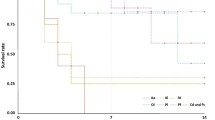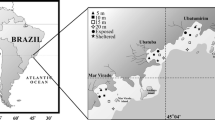Abstract
Four species of balanomorph barnacles, Balanus crenatus Brugière, B. balanoides (L.), Elminius modestus Darwin and Chthamalus stellatus (Poli), were studied to assess the susceptibility of intertidal barnacle species to desiccation. Known sized samples of barnacles were exposed to controlled desiccating conditions and subsequent survival and water loss were determined. It is clear that the ability to live high on the shore is dependent on a reduction of the overall permeability to water loss. Because of greater surface area to volume ratios, small stages are particularly prone to desiccation. In normal intertidal emersion periods, small stages of B. crenatus particularly, and also of B. balanoides and E. modestus which are similar in their desiccation resistance, would be susceptible to desiccation at normal temperatures and low humidities. Large barnacles would be more prone to death from high temperatures when the tide is out. The spat of C. stellatus, although surviving much longer than spat of larger dimensions of the other species, must also be prone to prolonged emersion conditions at high shore levels.
Similar content being viewed by others
Literature cited
Allanson, B. R.: Some aspects of the ecology of the molluscan genus Siphonaria in South Africa. Port. Acta biol. (B) 6, 179–212 (1958).
Augenfeld, J. M.: Respiratory metabolism and glycogen storage in barnacles occupying different levels in the intertidal zone. Physiol. Zoöl. 40, 92–96 (1967).
Barnes, H. and M. Barnes: Resistance to desiccation in intertidal barnacles. Science, N.Y. 126, 358 (1957).
— — and M. Barnes: Some relations between the habitat, behaviour and metabolism on exposure to air of the high level intertidal cirripede Chthamalus depressus (Poli). Helgoländer wiss. Meeresunters. 10, 19–28 (1964).
—, D. M. Finlayson and J. Piatigorsky: The effect of desiccation and anaerobic conditions on the behaviour, survival and general metabolism of three common cirripedes. J. Anim. Ecol. 32, 233–252 (1963).
Brown, A. C.: Desiccation as a factor controlling the vertical distribution of some South African gastropods from intertidal rocky surfaces. Port. acta biol. (B) 8, 11–23 (1960).
Crisp, D. J. and P. S. Meadows: Adsorbed layers: the stimulus to settlement in barnacles. Proc. R. Soc. (Ser. B) 158, 364–387 (1963).
— and D. A. Ritz: Changes in the temperature tolerance of Balanus balanoides during its life cycle. Helgoländer wiss. Meeresunters. 15, 98–115 (1967).
— and A. J. Southward: Different types of cirral activity of barnacles. Phil. Trans. R. Soc. (Ser. B) 243, 271–308 (1961).
Davies, P. S.: Physiological ecology of Patella. III. Desiccation effects. J. mar. biol. Ass. U.K. 49, 291–304 (1969).
Edney, E. B.: The water relations of terrestrial arthropods, 109 pp. Cambridge: University Press 1957.
Foster, B. A.: Tolerance of high temperatures by some intertidal barnacles. Mar. Biol. 4, 326–332 (1969).
—: Responses and acclimation to salinity in the adults of some balanomorph barnacles. Phil. Trans. R. Soc. (Ser. B) 256, 377–400 (1970).
Grainger, F. and G. E. Newell: Aerial respiration in Balanus balanoides. J. mar. biol. Ass. U.K. 45, 469–479 (1965).
Harvey, H. W.: The chemistry and fertility of sea waters, 240 pp. Cambridge: University Press 1955.
Kensler, C. B.: Desiccation resistance of intertidal crevice species as a factor in their zonation. J. Anim. Ecol. 36, 391–406 (1967).
Knight-Jones, E. W.: Laboratory experiments on gregariousness during setting in Balanus balanoides and other barnacles. J. exp. Biol. 30, 584–595 (1953).
Monterosso, B.: Studi cirripedologici. VI. Sul compartamento di Chthamalus stellatus in diverse condizioni sperimentali. Atti Acead. naz. Lincei Rc. 11, 501–505 (1930).
Newman, W. A.: Adaptive behaviour and physiology of estuarine barnacles. Proc. Symp. Crustacea, Mar. Biol. Ass. India 1038–1066 (1967).
Nicol, J. A. C.: The biology of marine animals, 707 pp. London: Pitman 1960.
Ramsay, J. A.: Methods of measuring the evaporation of water from animals. J. exp. Biol. 12, 355–372 (1935).
— and R. H. J. Brown: Simplified apparatus and procedure for freezing point determinations upon small volumes of fluid. J. scient. Instrum. 32, 372–375 (1955).
Ritz, D. A.: The effect of temperature on the activity and survival of barnacles. Thesis, University College of North Wales 1968.
Scatchard, G. and S. S. Prentiss: The freezing points of aqueous solutions. IV. Potassium, sodium and lithium chlorides and bromides. J. Am. chem. Soc. 55, 4355–4362 (1933).
Segal, E. and P. A. Dehnel: Osmotic behaviour in an intertidal limpet, Acmaea limatula. Biol. Bull. mar. biol. Lab., Woods Hole 122, 417–430 (1962).
Suzuki, N. and S. Mori: Adaptation phenomena concerning the water content of barnacles. Jap. J. Ecol. 13, 1–9 (1963).
Author information
Authors and Affiliations
Additional information
Communicated by J.E. Smith, Plymouth
Rights and permissions
About this article
Cite this article
Foster, B.A. Desiccation as a factor in the intertidal zonation of barnacles. Marine Biology 8, 12–29 (1971). https://doi.org/10.1007/BF00349341
Accepted:
Issue Date:
DOI: https://doi.org/10.1007/BF00349341




